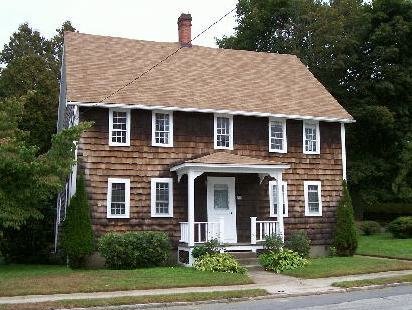
A view of the Hawkins house front entry porch.
So, my front porch is clearly a relatively new addition. My guess is that it was built either in the 1940s or 1950s, probably following the laying of the new foundation. It is of relatively simple construction, with subtle Victorian and transitional nuances. The previous owner, whose family owned my home for many generations, told me that the last major overhaul and repair of the porch infrastructure took place in the 1970s.

Architectural features include a boxed bearing beam, scalloped knee braces, and a tongue-and-groove ceiling.

The decking consists of 5/4 x 3 tongue-and-groove boards, probably Douglas fir. They are unfinished and very weathered, but generally in good condition, except for the exposed ends. The railing consists of simple linear balustrades.
The single biggest issuing facing my front porch is water damage. Except for its sloping deck, the relatively simple form of my porch exhibits very few elements of water-resistant design. It's obvious that the porch roof never even had a gutter system attached to it. Not even a drip edge under the shingles.

There's quite a bit of warping and splitting in the end grain of the decking boards. You can even see one large chunk lost to rot. Fortunately, the slab and steps appear to be sound. But there's no handrail! (A flagrant code violation in my locale).
Needless to say, it's a very wet porch in the rain and winter. The effects are obvious in the cupped, splitting ends of the decking boards, and in the deteriorating newel post bottoms. It was clear to me when I first bought the house that quite bit of the porch infrastructure and trim would need to be tended to at some point, and I had resolved to let the porch weather one last winter before I would finally deal with it this summer (2010).

A deteriorating and loose newel post bottom, and separating bottom rail. I temporarily braced the posts, and reattached the rails, with galvanized angles.
However, in the early spring, while taking a close look at the porch one morning, I noticed that the decking near each edge was separating, with the outermost boards being pushed slightly downward and over the edge. I also noticed a bottom rail detaching from one of the newel posts. It looked as if the columns had become detached at their bases and were spreading laterally across the deck, pushing the tongue-and-groove boards slightly apart. A simple test with a level confirmed that the columns were indeed out of plumb, with each base extending slightly outward.
I suspected that the column bases, or perhaps the decking just under the columns, had finally rotted to the point where fasteners were pulling out. A closer inspection revealed both conditions, to varying degrees. But what surprised me was the fact that none of this was obvious back in the fall. So I further surmised that snow loading this past winter (we had several heavy snow falls) must have forced the columns to move.
The column on the north side of the porch had the most rot. A large area of peeling paint revealed something of a Dutchman in the trim at the bottom of the column (yet even more suspiciousness, of course, as it suggests there had been problems here in the past).

The mysterious Dutchman (albeit, not a Flying Dutchman) that appeared in the spring. You can also plainly see the effect on the decking boards of the column movement.
Removing the Dutchman revealed a scary amount of wet, mushy, rotted wood. In fact, one could even well conclude that the bottom of the interior 4x4 post was mostly gone and that only the exterior 1x trim was supporting the column. (And the bottom part of the trim wasn't in much better shape). Probing with a drill revealed that the interior post was still solid about 8" above the deck.

Behind the Dutchman was a scary mass of rot. You can even see a corroded fastener near the bottom, right-hand side of (what had been) the interior post.

Needless to say, I quickly replaced the Dutchman, as I couldn't bear looking at it anymore. Some of the 1x trim, which was also soft in this area, broke away when I had initially pulled the Dutchman out.
The column on the south end of the porch was in much better shape. Probing revealed that the interior post was solid and dry nearly all the way to the bottom. However, the decking itself right under the column was rotted. In fact, the end of the board under the center of the column had broken free where it rotted, and I was able to easily extract it with my hand. The south column also appears to have traveled farther from its original position than the north column.

The column on the south end of the porch and the compromised tongue-and-groove just under it. Note the exterior trim splitting under the weight.
I subsequently crawled under the porch, and found all the structural members (ledger, joists, posts, etc.) in reasonably good shape. Apparently, the water assault had been borne by everything up above, and no significant damage had yet worked its way down. And I still need to get up to the roof and inspect the sheathing and bearing beam. But at least I've isolated all the lower infrastructure damage for now...
And The Moral Of This Story Is....
Porches and decks serve different functions and have their own sets of problems. But both are susceptible to damage caused by water infiltration. You should inspect your porch or deck to ensure that rain water adequately drains away from structural features, and that ventilating air can likewise flow freely to dry things out. You should also inspect your porch or deck each season for water or insect damage, and speedily correct any problems. And even better yet...hire a licensed professional to do all of this for you.
In all fairness, most of the major problems currently facing my house preceded me here. However, some are more serious than others, and in this particular case, I had been somewhat ambivalent about the relative urgency, believing that relegating corrective action to a scheduled event would somehow make everything okay. However, nature often has plans much different from our own, and I was just lucky to catch this one before things got worse.
In a follow-on posting, I'll show you the steps I immediately took to temporarily shore the porch up and ensure its safety before undertaking proper repair of the porch infrastructure.
Resources and Further Reading
Ermides, Chris. "The Rot Proof Porch", Fine Homebuilding Magazine (No. 212), July, 2010. Taunton Press, Newtown, CT.
Guertin, Mike. "Is Your Deck Safe? 8 Critical Areas to Inspect Every Season", The Best of Fine Homebuilding: Decks & Outdoor Projects. Summer, 2010. Taunton Press, Newtown, CT.
Lintow, Sean. "May is National Deck Safety Month". The Homeowner's Resource Center, SLS Construction. April 25, 2010.
The JLC Guide to Decks and Porches: Best Practice for Outdoor Spaces. The Journal of Light Construction. Hanley Wood, LLC. 2010, Williston, VT:
-- Katwijk, Kim & Linda. "Rot-Resistant Details". pp. 125-129.
-- Leeke, John. "Replacing Rotted Wood Columns". pp. 348-350.
-- Nicolazzi, Peter & Maureen. "Porch Repair From The Bottom Up". pp. 343-347.
-- Smith, Scott. "Site-Built Under-Deck Drainage". pp. 148-154.
















